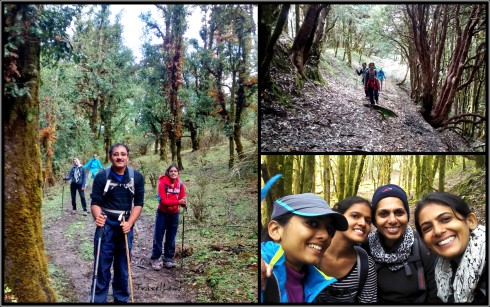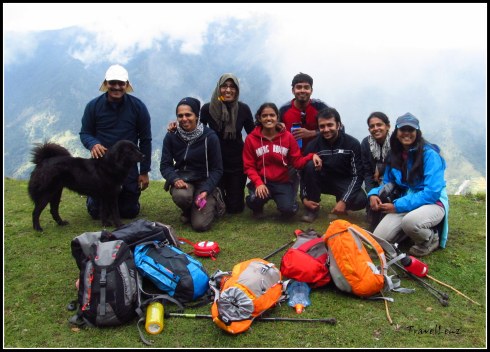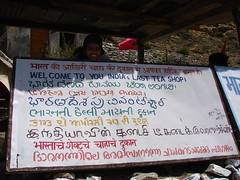Day 3: September 30
After a night of tossing and turning, we woke up at the crack of dawn.
Imagine waking up and rolling out of bed to be greeted by a misty mountain view, with the sun peeping out and pink skies above you. Well, in a tent you do not roll out, but crawl out. For the next few days we were to follow a few steps, or rather crawls and crouches, while getting in and out of a tent.
While getting out of a tent
- Unzip your sleeping bag, which invariably gets stuck, the more you rush.
- Sit in a crouching position.
- Unzip the inner tent opening.
- Crawl out till the inner tent opening, still struggling to free yourself from the clutches of your sleeping bag.
- Now sit back down and stick your leg out so that you can put on your shoes.
- Unzip the outer tent opening.
- Lift yourself up still crouching and walk out of the tent.
While getting in
- Open the outer zip.
- Open the inner zip.
- Have your back against the tent door and fall onto your rear (ouch!!!), your legs still jutting out of the tent.
- Remove your shoes and crawl into the tent.
PS: And every time you remove/put on your shoes while you enter/exit the tent….arduous!
Armed with our tooth brushes we walked towards the fiberglass tents. Ali Bugyal camp did not have a running water source so we had to make do with the minimal water available which was stored in plastic containers. When you’re deep in the woods, miles away from the nearest restroom, it takes some extra effort to take care of your ‘business’ in a hygienic way. With generous dollops of hand sanitizer, tissue paper and wet wipes, keeping clean was often a struggle. Without the modern conveniences we’ve become so accustomed to, keeping up with the bacteria, dirt, and grime was a constant challenge. At least, everyone smells equally bad on a high altitude trek. But it didn’t matter – we were all bundled up in many layers to smother the scent. And who actually cared – after all we were not there to take part in a beauty contest.
In ten minutes we were holding onto our glasses of hot tea and taking in the vista in front of us. Green valleys spread out before us with a few clouds looming in the sky. A thick layer of fog hung throughout the valley, making it impossible to see what lay behind. Above the fog layer, the sky was a mixture of grey and pink.
The weather cleared slowly, the fog lifted and as the sun broke through the clouds, we could see the rim of the snow capped mountains, jutting out like vanilla cones sprinkled with dark chocolate – we were pointed out the Trishul peaks, Chaukhamba and Kali Dak. We spent some time on a vantage point taking snaps till the breakfast call came.By 8.30 our luggage was loaded onto the mules and the first set of trekkers were already on their way. We walked up from the camp, passed a stone temple and were now hiking on the huge Z mark we had seen the previous day. The hike was not tough as we were passing on plain trails.
Our next camp was Pathar Nachauni, 5 km away. The trail to Pathar Nachauni was along a mountain edge, a narrow path with mountains on one side and a sloping valley on the other side.
In half an hour we were walking by another Himalayan meadow – Bedni Bugyal. Bedni Bugyal lay down in the valley on our left. In the middle of the grass land there was a pond – Bedini Kund. Locals believe that Maharishi Ved Vyas compiled all the four Vedas in this valley. There were two small stone temples near the Bedini Kund. We could also see a camping site, complete with a dozen tents and a couple of fiberglass tents.
We would be cutting through the Bedni Kund on our way back. There are two approaches to the meadows of Bedni Bugyal from the plains, one from Loharjung via Didna, Tolpani and Ali Bugyal – which we had taken – and the other, a steep climb directly from Wan village. We ascended through the first and would descend the other way.Near the Kund, we could see a line of trekkers from another group. They were struggling as they climbed from the valley along a steep zig zag path to reach the main mountain trail we were moving on. We did thank our stars that we did not have to go through that steep climb in the morning. On our way back we would be taking that path down.
The trek today would take us through Ghora Lautani before we reach our camp at Pathar Nachauni. Ghora Lotani stands at a height of 3945 m and is about 2.5 kms from Ali Bugyal. It gets such a name because horses would never go up from this place – the place from where the horses returned home.
By 11 we reached Ghora Lautani. As there was a chance of rain, we were instructed to get into our rain wear immediately. The clouds had started to build over the mountains and there was an occasional peal of lightning accompanied by a flat rolling roar. Till now the nature Gods were pleased with us and we had not faced any showers, hail or snow.
After Ghora Lautani, we had now moved onto the other side of the mountain. There were signs of major landslides that looked really scary.
The valleys looked browner than green, a sign that we were gaining altitude. The valley was covered with clouds which shielded the white peaks of Trishul and Nanda Ghunti.
From Ghora Lautani to Pathar Nachauni (1.5 kms), the trek was easy, almost going downwards. After 30 minutes or so we could spot a campsite on the right side, which belonged to another trek company, amidst an extensive alpine meadow down in the valley. The camp looked colourful with a dozen yellow and orange tents. Our campsite was further up on a ridge on the left side of our trail. By 11.50 we trickled into Pathar Nachauni. We were now standing on ground that was 12766 ft (3900 m) above sea level.
The camp consisted of two rows of 16 tents, 8 on one side bang opposite to each other. There was a huge mess tent, a few fibre glass tents and a shed for the mules. The toilet tents were placed further away up on the ridge. There was a small dhaba right in front of the camp.
We had barely reached the camp and it started to rain.
The food provided throughout the trek by TTH was of top quality. Our menu was never repeated, and we were served with a variety of dishes. After a sumptuous lunch we thought we’d explore the place with Raj Bhaiyya. The rain had stopped now, but the whizzing Himalayan icy winds were on the prowl. Pathar Nachauni is a brown meadow, sprinkled with rocks – small and large.
Raj bhaiyya told us story, a popular folklore associated with the name of this place. A local King, on a pilgrimage to Nanda Devi, stayed at this place. He was traveling with a large group which also included a few dancers. The King got so lost in their performance that he finally forgot about the pilgrimage. Nanda Devi cursed the King and turned all dancing girls into rocks – thus the name Pathar Nachauni. An interesting story indeed.
The path from our camp led up to a steep hill and we were to follow this winding path tomorrow. The small temple of Kalu Vinayak lay somewhere amidst the mountains ahead of us. The trail between Pathar Nachauni and Kalu Vinayak is considered as the most difficult stretch to cover, because of the steep climb and altitude gain.
Tomorrow we would be camping higher – at the highest camp of this trek – Bhagwabasa. And tomorrow we would also get the first glimpse of our destination – Roopkund lake – or at least the mountain where Roopkund lay hidden in a shallow crater. Tomorrow is always better than today.Day 3 in a nutshell
- Day 3: Ali Bugyal to Pathar Nachauni via Ghora Lautani
- Distance: Around 5 kms
- Altitude: 11520 ft to 12700 ft [3510 m to 3900 m]
- Terrain: Gradual ascent from Ali Bugyal to Ghora Lautani and downhill trek from Ghora Lautani till Pathar Nachauni.
- Difficulty: Easy
- Time taken: Around 3.5 hours





![Kalidak and Trishul [courtesy Ammu]](https://travellenz.files.wordpress.com/2016/04/dscn7115.jpg?w=490)
![Chaukhamba from Aki Bugyal [Courtesy Ammu]](https://travellenz.files.wordpress.com/2016/04/dscn7109.jpg?w=490)


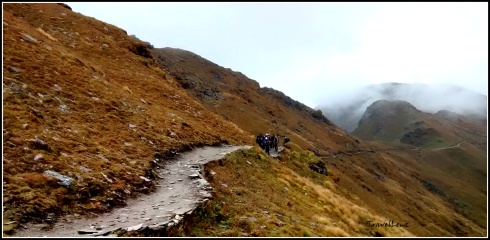
![Bedni Kund [Courtesy Ani & Sabari]](https://travellenz.files.wordpress.com/2016/04/img_5349.jpg?w=490)








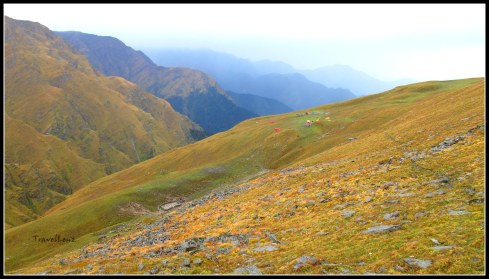

![Team @ Pathar Nachauni...and don't miss the pink gloves [courtesy Ani & Sabari]](https://travellenz.files.wordpress.com/2016/04/img_5417.jpg?w=490&h=389)







